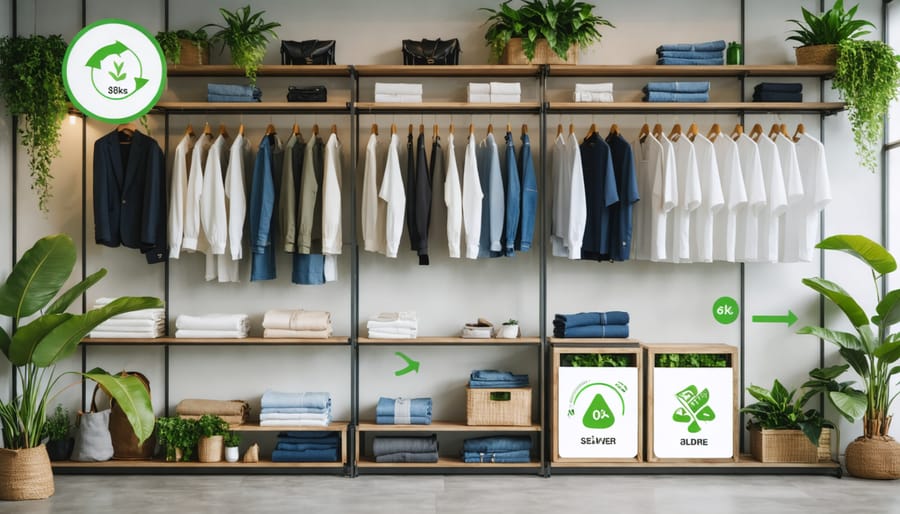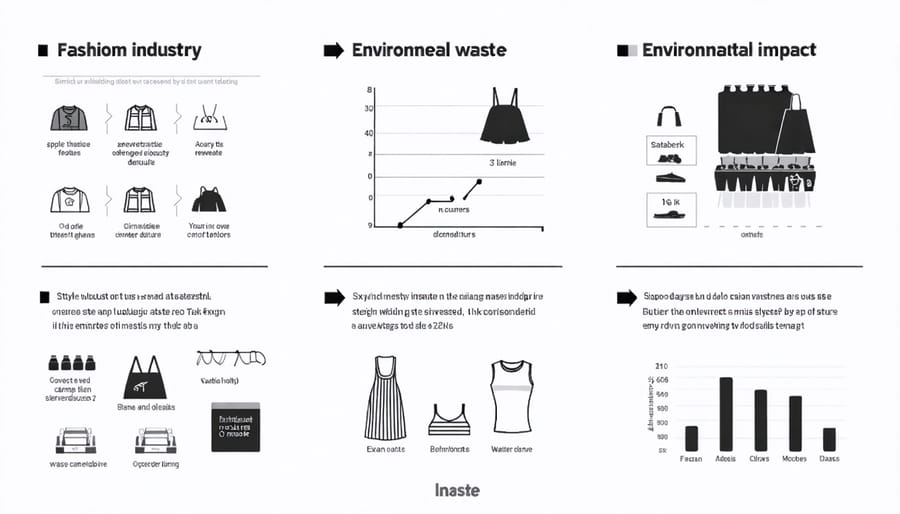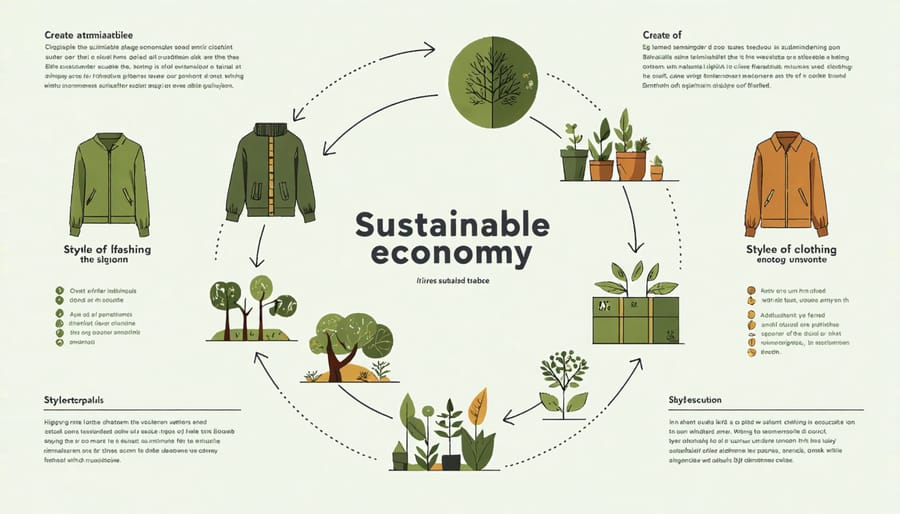
Every three seconds, the equivalent of one garbage truck full of textiles is landfilled or burned globally – a stark reality unveiled by the Ellen MacArthur Foundation’s groundbreaking research on fast fashion’s environmental impact. The fast fashion industry, producing over 100 billion garments annually, has transformed from a seasonal business model to one that introduces new styles weekly, creating an unsustainable cycle of consumption and waste. While this system generates $2.5 trillion annually, it comes at a devastating environmental cost: consuming 98 million tonnes of non-renewable resources and releasing half a million tonnes of microfibers into our oceans each year. The Foundation’s circular economy vision offers a revolutionary alternative, championing a system where clothes are designed to last longer, be worn more, and be fully recyclable. Their research isn’t just exposing problems – it’s illuminating a path toward a more sustainable fashion future where style and environmental responsibility coexist harmoniously.
The Fast Fashion Crisis: By the Numbers
The Environmental Price Tag
When I learned about the environmental costs of fast fashion from the Ellen MacArthur Foundation’s research, I was genuinely shocked. Did you know that the fashion industry uses about 93 billion cubic meters of water annually? That’s enough to meet the needs of 5 million people! But water usage is just the tip of the iceberg.
The fashion industry currently accounts for about 10% of global carbon emissions – more than all international flights and maritime shipping combined. Every second, the equivalent of one garbage truck of textiles is landfilled or burned globally. Even more concerning, less than 1% of used clothing is actually recycled into new garments.
What really puts things in perspective is the microfiber problem. Every time we wash our synthetic clothes, tiny plastic particles enter our waterways. We’re talking about half a million tons of these microfibers reaching our oceans each year, affecting marine life and eventually making their way into our food chain.
The foundation’s research shows that if nothing changes, by 2050 the fashion industry could use up to 25% of the world’s carbon budget for keeping global warming under 2°C.

The Fashion Industry’s Carbon Footprint
When I learned about the fashion industry’s environmental impact through the Ellen MacArthur Foundation’s research, I was stunned by the numbers. The fashion industry currently produces about 10% of global carbon emissions – that’s more than all international flights and maritime shipping combined! Each year, the industry uses around 93 billion cubic meters of water, contributing to severe water stress in many regions.
What’s even more concerning is that these numbers are expected to grow. If current trends continue, the fashion industry could use up to 26% of the world’s carbon budget by 2050. To put this into perspective, that’s the emissions equivalent of what 230 million passenger vehicles would generate in a year.
The production process is particularly resource-intensive. Creating just one cotton t-shirt requires about 2,700 liters of water – what one person drinks in 2.5 years! And when it comes to synthetic materials like polyester, the production process releases twice as many carbon emissions as cotton.
These statistics aren’t meant to overwhelm us but rather to help us understand why making mindful fashion choices is so important for our planet’s future.
Making Sustainable Fashion Choices

Building a Capsule Wardrobe
Building a sustainable wardrobe doesn’t mean sacrificing style or breaking the bank. In fact, learning to revamp your wardrobe on a budget can be an exciting creative challenge that benefits both your wallet and the planet.
Start by assessing what you already own and identifying your most-worn pieces. These items form the foundation of your capsule wardrobe. Choose versatile basics in neutral colors that can be mixed and matched easily – think a well-fitted blazer, classic white shirt, comfortable jeans, and a little black dress.
Aim for quality over quantity. While premium pieces might cost more initially, their longevity makes them more cost-effective in the long run. I learned this lesson after replacing cheap t-shirts multiple times, when one high-quality option would have lasted years.
Focus on selecting pieces that:
– Can be styled at least three different ways
– Suit your lifestyle and daily activities
– Make you feel confident and comfortable
– Are made from durable, sustainable materials
Remember to include a few statement pieces that bring personality to your outfits. These could be bold accessories, a vintage jacket, or a beautifully patterned scarf. The key is ensuring each item earns its place in your wardrobe through regular wear.
By maintaining a thoughtfully curated collection of around 30-40 pieces, you’ll simplify your daily choices while reducing your environmental impact.
Quality Over Quantity
When building a more sustainable wardrobe, investing in timeless fashion pieces isn’t just better for the planet – it’s also smarter for your wallet. I’ve learned through experience that quality pieces might cost more upfront, but they often last years longer than their fast-fashion counterparts.
Look for well-constructed garments with these telltale signs of quality: even stitching, natural fibers like cotton, wool, or silk, and sturdy hardware like zippers and buttons. When shopping, don’t just look at the price tag – check the seams, feel the fabric weight, and ask yourself if this piece will still be in style three years from now.
I always recommend the “cost per wear” calculation: divide the item’s price by how many times you’ll likely wear it. That $200 well-made blazer you’ll wear weekly for years suddenly becomes more economical than a $30 trendy top that falls apart after three washes.
Some of my favorite investment pieces include:
– A perfectly fitted wool coat
– High-quality denim in a classic cut
– Well-constructed leather boots
– A versatile silk blouse
– A tailored blazer in a neutral shade
Remember, building a quality wardrobe takes time. Start by replacing one fast-fashion piece at a time with a better-quality alternative. Your closet – and the planet – will thank you for it.
Circular Fashion: The Future of Style
What is Circular Fashion?
Imagine your favorite piece of clothing having multiple lives, being loved by different people, and never ending up in a landfill. That’s the essence of circular fashion! Unlike the traditional “take-make-waste” model, circular fashion creates a closed loop where clothes are designed, produced, and used in ways that eliminate waste and pollution.
Think of it as nature’s way of doing things – where nothing goes to waste. In circular fashion, garments are made from safe, renewable materials, designed to last longer, and can be easily repaired, resold, or recycled. When a piece of clothing reaches the end of its life with one person, it becomes the beginning of something new for another.
The Ellen MacArthur Foundation has been pioneering this concept, showing how we can transform the fashion industry from a linear to a circular model. It’s not just about recycling; it’s about rethinking how we design, make, and use our clothes. From choosing biodegradable materials to supporting brands that offer repair services, every small choice we make can contribute to this revolutionary approach to fashion.

Brands Leading the Change
Several forward-thinking brands are leading the charge in transforming the sustainable fashion industry. Stella McCartney has been a pioneer, implementing innovative recycling programs and using eco-friendly materials like mushroom leather. Patagonia continues to impress with their Worn Wear initiative, which repairs and resells used clothing while educating consumers about extending product life.
H&M’s Conscious Collection demonstrates how larger retailers can embrace sustainability, with their garment collection program having collected over 29,000 tonnes of textiles for recycling since 2013. Reformation has set new standards for transparency, sharing their environmental impact data and manufacturing processes with customers.
Smaller brands like Mud Jeans are revolutionizing ownership models through their innovative lease-a-jean program, while Eileen Fisher’s Renew program gives previously-loved garments a second life. These brands prove that fashion can be both stylish and sustainable, showing others in the industry that circular principles aren’t just good for the planet – they’re good for business too.
Simple Steps for a Sustainable Wardrobe
Building a sustainable wardrobe doesn’t have to feel overwhelming. I remember when I first started my journey toward more conscious fashion choices – it began with small, manageable steps that made a big difference over time. Let me share some simple ways you can get started too!
First, embrace the “30 wears test” before buying anything new. Ask yourself: “Will I wear this at least 30 times?” This simple question helps avoid impulse purchases and ensures you’re investing in pieces you’ll truly love and use.
Start by auditing your current wardrobe. Pull everything out and sort items into three piles: keep, repair, and donate. You might be surprised to find forgotten gems or pieces that just need a quick fix to become favorites again.
When shopping, prioritize quality over quantity. Look for well-made garments with sturdy seams and natural materials that will last longer. Yes, they might cost more initially, but they’ll save you money in the long run and reduce waste.
Learn basic clothing care and repair. Simple skills like sewing on buttons or fixing small tears can extend your clothes’ life significantly. Consider hosting a clothing swap with friends – it’s a fun way to refresh your wardrobe without buying new items.
Explore rental services for special occasions instead of buying one-off pieces. Many local and online platforms offer designer clothes for short-term use, perfect for those wedding seasons or important events.
Finally, research brands committed to sustainable practices. Look for transparency in their production processes and materials used. Remember, every conscious choice counts, and small changes add up to significant impact over time.
The journey toward sustainable fashion starts with each of us making mindful choices. As we’ve learned from the Ellen MacArthur Foundation’s research, the fast fashion industry’s impact on our planet is significant, but positive change is possible. By embracing circular fashion principles, extending the life of our clothes, and supporting brands committed to sustainability, we can contribute to a healthier fashion ecosystem.
Remember, every small decision counts – from choosing quality over quantity to caring properly for your garments. Let’s make conscious fashion choices that reflect not just our style, but our values and commitment to a more sustainable future. Together, we can transform the fashion industry from a linear system to a circular one, creating positive change for both our wardrobes and our world.
Start your sustainable fashion journey today. Your choices matter, and they’re helping shape a better tomorrow for generations to come.



